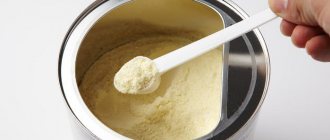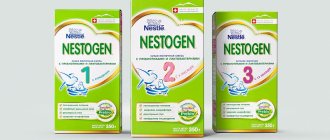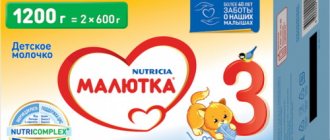Fermented milk mixtures are useful for normalizing digestion in children under one year of age and older. Almost every manufacturer used to have a mixture marked “KM” in its line.
"Nestozhen 3" from Nestlé is a fermented milk mixture for children over one year old.
Swiss quality is achieved only by the work of highly qualified specialists and the use of proven raw materials without dyes, preservatives and flavors.
Previously, you could find “Nestozhen Fermented Milk 1” and “Nestozhen 2” on store shelves, but now these two types of food have been discontinued (partly due to the emergence of new generation formulas - “comfort”).
So, we will look at “Nestozhen 3”, also known as “Nestozhen fermented milk” in this article.
Reasons for bottle feeding
Breast milk substitutes, for example, the “Nestozhen 1” formula, are, under certain circumstances, a good, but not equivalent, replacement for breastfeeding. Medical experts strongly recommend breastfeeding, if possible, for at least 1 year of age.
It is necessary to introduce artificial formula into a baby’s diet only if it is justified from a medical point of view.
The reasons for which it is impossible to breastfeed can be relative and absolute.
Pediatricians' opinion
All pediatricians rightly believe that breast milk is the best nutrition for a baby. But if for certain reasons breastfeeding is impossible, then it is necessary to find a high-quality mixture that compensates for all the body’s nutritional needs and does not cause allergies.
Reviews from pediatricians regarding Nestozhen 1 for newborns are only positive. Doctors claim that the product has a rich nutrient composition and optimal milk protein content. It is able to fully compensate the body's needs for nutrients, vitamins and microelements.
Reviews from Dr. Komarovsky
Komarovsky's reviews regarding this product are positive. The pediatrician highlights several strengths of the mixture: the ability to use from birth, effective prevention of digestive problems due to prebiotics and lactobacilli, a balanced fortified composition.
Contraindications from the mother
Breastfeeding is limited or impossible in the following cases:
- when breast milk contains substances or microorganisms hazardous to the baby’s health;
- somatic pathologies of the mother, severe diseases of the cardiovascular system;
- HIV infection in mother;
- dangerous infectious diseases - plague, anthrax, cholera, smallpox, typhus and others;
- oncology, in which the mother’s condition is extremely serious, as well as taking antitumor drugs, chemotherapy, radiation, radioisotope drugs that pass into breast milk and negatively affect the baby;
- tuberculosis in open form with the release of bacteria, since the newborn is very sensitive to infection and the risk of infection is high;
- if the mother lacks breast milk - in the event that it is not possible to establish full lactation.
A controversial issue today concerns the admissibility of feeding a child with hepatitis C in the mother; there is a lot of disagreement about this among scientists around the world.
There is an opinion that breastfeeding is allowed only in the absence of virus circulation in the blood plasma and with linings, but if there is active viremia (viruses enter the bloodstream and can spread throughout the body), breastfeeding is completely prohibited.
Important!
- ARVI, sore throat, bronchitis, pneumonia are not a reason to give up breastfeeding. You can apply it to the breast after the temperature drops and the woman’s general condition improves. In this case, it is better for the mother to use a mask when communicating with the baby.
- In case of mastitis, if there is no pus coming from the nipples, breastfeeding is also possible.
- If the mother has Rh-negative blood (if there is an antibody titer in the blood), breastfeeding is also not canceled at present: there is an opinion that antibodies are destroyed in the newborn’s stomach and are therefore not dangerous.
"Nestozhen Low Lactose"
For children from birth to one year with (decreased activity of the lactase enzyme that breaks down lactose), “Nestozhen Low Lactose” is produced in the “Nestozhen” line of mixtures. This mixture belongs to specialized nutrition and can only be prescribed by a pediatrician. Low-lactose formulas are usually indicated for bottle-fed children, since the complete exclusion of lactose from a newborn’s diet threatens the development and disruption of the formation of the nervous system. It is impossible to say in advance whether this mixture is suitable for your child, since it all depends on the degree of lactase reduction in the body. It is possible that this concentration of lactose will be too high and after several days of use you will have to give preference to a mixture with an even lower lactose content. Since the lactose content in the mixture is reduced, glucose syrup gives it a sweet taste. A distinctive feature from other Nestozhen mixtures is the addition of nucleotides, which are needed to restore the intestinal walls after diarrhea.
Contraindications for breastfeeding for a baby
Situations for introducing formula, for reasons related to the child:
- congenital heart and brain defects of the newborn;
- extreme prematurity, when the baby is unable to breastfeed independently;
- neonatal sepsis;
- leucinosis, Menkes disease, or maple syrup-smelling urine disease;
- phenylketonuria, a hereditary disease associated with impaired metabolism of amino acids, mainly phenylalanine;
- galactosemia of the newborn, when a metabolic disorder occurs in the conversion of galactose to glucose.
The above cases are objective reasons for switching to artificial feeding.
There are also cases when a woman avoids breastfeeding in order to maintain a “good shape” of her breasts. Before making such a decision, a mother should think carefully and decide what is more important to her - the child’s health or beautiful breasts. Women must realize that even the highest quality artificial nutrition cannot replace the uniqueness of breast milk.
Important! Think carefully before you voluntarily give up breastfeeding, and thereby leave your baby without mother’s milk, which is vital for its full growth and development. The introduction of artificial formulas into a child’s diet should be carried out after consultation with a pediatrician or neonatologist; he will help to correctly assess the need for this measure and determine the appropriate product.
Composition of mixtures Nestozhen
As mentioned earlier, Nestozhen mixtures differ in composition.
| Mixture | Compound |
| Nestozhen 1 for newborns | Linoleic, folic, pantothenic acids, vegetable fats, whey proteins (14%), lactose, maltose (22.5 g), prebiotics (4 g), vitamins of all groups, microelements. |
| Unstable 2 6 to 12 months with rice flour | Contains carbohydrates, prebiotics, proteins, fatty acids, lactose, vitamins and rice flour. |
| Unstable 2 from 6 to 12 months with prebiotics | Contains the same set of components with carbohydrates. But in this case, the content of whey, lactose, minerals and vitamins is increased. The composition is created taking into account the baby's needs for various microelements. Therefore, the mixture is more satisfying. |
| Unstable 3 from 12 to 18 months | The set of substances is the same, but in increased quantities per liter of water. |
| Nestozhen 4 from 1.5 to 2 years | The composition has been slightly changed - the amount of vitamins, microelements and prebiotics has been increased. |
Nestogen is available in packs of 350 and 700 grams. Due to its low cost, ease of use and adapted composition, in comparison with similar foods, the mixtures are loved by many mothers.
Advantages and disadvantages
Breastfeeding substitutes, of course, differ from maternal feeding and have a number of advantages:
- frees up free time, which is important for a young mother with a lack of free time and a lot of worries; the mother can even leave home, since any family member can feed the baby;
- the mother can allow herself to eat well, without limiting herself in anything, and this is very important in the postpartum period for a woman, when the load is great, and at the same time the body must receive all the necessary substances to recover;
- control over the child’s diet - the mother knows exactly what formula she is giving; if an allergy occurs, it is enough to change it to another, but with natural feeding we are talking about a complete change in the diet of the nursing mother.
The most significant disadvantage of artificial feeding is that the newborn’s intestinal microbiota is just forming and the immune system is developing, so during this period he is still poorly protected and is susceptible to various diseases, including allergic ones.
Normally, a healthy full-term newborn baby has a special, different from an adult, state of the immune system, which is biologically appropriate. From the sterile conditions of intrauterine development, a child comes into a world where from the first second of life (and even during childbirth) he is bombarded with a huge number of previously unfamiliar antigens.
However, nature has ensured that the state of the newborn's immune system inhibits the excessive immune response that would occur to such enormous antigenic stimulation. This becomes possible due to the immaturity of many parts of the immune system and the increased function of suppressor (that is, restraining) factors of immunity.
In newborns, the activity of most nonspecific protection factors is reduced. Thus, their skin is thin, its structure is immature, the pH is insufficient, as a result of which the skin has increased permeability and susceptibility to infections.
Postpartum skin-to-skin contact between mother and newborn and, of course, receiving a few drops of colostrum are very important for the development of normal flora in the newborn.
Colostrum, formed during the first days of lactation, is a very valuable nutrition for the baby: it is rich in valuable nutrients, hormones, vitamins, growth factors, immunoglobulins and many other anti-infective defense factors.
If the baby does not receive colostrum, but subsequently breastfeeding is established, then the baby will receive all the necessary components.
If artificial feeding is an inevitable necessity, the mother must take the choice of formula very seriously, study the rules for its storage and method of preparation.
Adapted Nestozhen mixtures have the following advantages:
- recommended for infants from birth;
- contain a complex of vitamins and minerals that provide a balanced, healthy diet for the baby;
- the mixture contains prebiotics Prebio and lactobacilli L.reuteri, which promote comfortable digestion;
- thanks to prebiotics, intestinal motility improves, regular soft stools are formed, healthy microflora is formed and colic is reduced;
- ensures sweet sleep for the baby, because the tummy does not bother you;
- a developed network of suppliers - you can buy in almost any supermarket or online store;
- affordable price;
- pleasant taste and smell;
- no palm oil;
- high quality raw materials produced by specially selected suppliers, without the use of genetically modified ingredients, preservatives, dyes and flavors.
The disadvantages of Nestozhen mixtures include:
- not suitable for children prone to allergic reactions;
- according to some consumers, the product inside the package is sealed in an uncomfortable soft bag (this refers to the disadvantages of the packaging rather than the mixture);
- strong sweet taste (many people like it);
- long period of dissolution of the mixture upon contact with water.
Young mothers, when forced to decide on artificial feeding, should pay attention to high-quality, time-tested products; they must listen to the opinions of experts.
Choosing products from the Swiss company Nestle under the Nestozhen brand allows you to fully feed your baby, strengthen his health, immunity and improve digestion.
Baby formula "Nestozhen" includes a complex of essential vitamins, minerals, and beneficial elements:
- whey protein, which is well absorbed and digested by the child’s body;
- probiotics (lactobacteria L.reuteri), which contribute to the formation of healthy microflora and regular soft stools, improving intestinal motility;
- contains prebiotics (TOS, FOS);
- contains α-linolenic fatty acid;
- contains maltodextrin - molasses with a sweet taste.
Another disadvantage of the Nestozhen mixture is that it does not contain essential polyunsaturated fatty acids of the Omega-3 class - DHA and ARA, which have a beneficial effect on the development of the brain, intelligence, and are involved in the formation of the organs of vision and hearing.
Reviews of infant formula
According to reviews, Nestozhen 1 is suitable for feeding newborns. Users note in reviews of the mixture from birth that the product does not cause allergies, and babies eat it with pleasure.
There are also reviews from mothers who note that with a balanced composition without palm oil, Nestogen 1 is relatively inexpensive when compared with many other mixtures with a similar composition.
Reviews about the mixture boil down to the fact that babies take the new baby food with pleasure and at the same time tolerate it well. Nestozhen does not cause constipation, colic, regurgitation and other digestive disorders. Babies do not have green stool from formula.
Many parents switch from Nutrilon to Nestozhen 1. The latter is easily accepted by the baby and helps normalize digestion.
There are also reviews where mothers tell how they give Nestozhen Fermented Milk 1 to newborns with mixed feeding. The food can be given to both babies from birth and older children. Nestozhen Fermented milk helps normalize digestion during constipation, frequent regurgitation, and bloating.
Ruler Nestozhen 1, 2, 3, 4
It is currently impossible to purchase an equivalent replacement for breast milk.
However, the composition of most modern formulas for artificial feeding contains identical components: vitamins and minerals, proteins, carbohydrates, fats. Products that are most similar to breast milk are called adapted.
Mixtures with medicinal properties are recommended for children with allergic diseases or serious digestive disorders. These mixtures eliminate allergies, lactose intolerance, colic, and constipation.
When choosing one or another mixture, you must seek advice from a pediatrician who knows the specifics of the body of a particular child.
The Swiss company produces the following types of infant formula under the Nestozhen brand:
New Nestogen 1 Blend
The Nestozhen mixture now has an improved recipe, new packaging and design. Adapted milk formula "Nestozhen 1", intended for infants from birth to 6 months.
A mixture of “Nestogen 1” with Prebio prebiotics and L.reuteri probiotic improves intestinal motility, promotes the formation of regular soft stools, beneficial microbiota and prevents colic. Healthy intestinal microflora influences the state of the immune system and is important for maintaining, developing and strengthening the immune system.
Composition of the mixture: in addition to a complex of essential vitamins and minerals, it also contains Omega-3 docosahexaenoic acid, an α-linolenic essential fatty acid, which is important for the development and normal functioning of the brain. Nucleotides play a key role in many biological processes. They serve as the basis for the construction of DNA and RNA and, in addition, are responsible for protein synthesis and genetic memory, being universal sources of energy.
Nucleotides are part of coenzymes and take part in carbohydrate metabolism and lipid synthesis. In addition, nucleotides are components of active forms of vitamins, mainly group B (riboflavin, niacin). Nucleotides contribute to the formation of natural microbiocenosis, provide the necessary energy for regenerative processes in the intestine, and influence the maturation and normalization of the functioning of hepatocytes.
Lutein has antioxidant properties, it ensures the proper formation of the organ of vision and its protection.
Iodine – participates in the functioning of the nervous and endocrine systems. Zinc and selenium help improve immunity, calcium is good for teeth and bone tissue.
Unstable 1 mixture composition table of components is given below:
- Age group: infants from 0-6 months.
- Weight: 300; 700, 1050 grams.
- Use: in case of complete absence or lack of breast milk.
- Components: the product contains carbohydrates, fats, proteins: casein 40 and whey proteins 60, the most important vitamins and minerals that contribute to the normal development of the baby's body. Natural prebiotics (GOS, FOS) normalize stool and promote normal digestion. Probiotics (lactobacteria) promote the growth of healthy microbiota and the development of the baby’s immune system, and the formation of regular soft stools.
- Osmolality 247 mOsm/kg.
- Energy value is 67 kcal per 100 ml of the finished mixture.
- Price: about 261-320; 475-577; 760 rubles respectively.
New Nestogen 2 Blend
Nestozhen 2 also has an improved recipe, new design and packaging. Breast milk substitute "Nestozhen 2" is intended for feeding children from 6 months to 1 year. The mixture can be used as a dairy component of the baby's menu, or in addition to complementary feeding products.
Natural prebiotic fibers (GOS, FOS) promote normal digestion. Lactobacilli L.reuteri improve intestinal motility, help the formation of regular soft stools and the formation of a healthy microbiota in the baby. It also contains essential fatty acid (α-linolenic acid), a complex of vitamins and minerals that contribute to the optimal growth and development of the child. The product's properties are as close as possible to breast milk; its balanced composition ensures good digestion.
In addition to a complex of essential vitamins and minerals, it also contains Omega-3 docosahexaenoic acid, an α-linolenic essential fatty acid, which is important for the development and normal functioning of the brain.
Nucleotides play a key role in many biological processes. They serve as the basis for the construction of DNA and RNA and, in addition, are responsible for protein synthesis and genetic memory, being universal sources of energy. Nucleotides are part of coenzymes and take part in carbohydrate metabolism and lipid synthesis. In addition, nucleotides are components of active forms of vitamins, mainly group B (riboflavin, niacin). Nucleotides contribute to the formation of natural microbiocenosis, provide the necessary energy for regenerative processes in the intestine, and influence the maturation and normalization of the functioning of hepatocytes.
Lutein has antioxidant properties, it ensures the proper formation of the organ of vision and its protection.
- Age group: nutrition for children aged 6-12 months.
- Weight: 300; 700, 1050 grams.
- Use: dairy product, when introducing complementary foods or as an addition to complementary foods.
- Ingredients: prebiotics (GOS, FOS), probiotics of lactobacilli L.reuteri, improve digestion, help form regular, soft stools. The product contains proteins, fats, carbohydrates, a complex of vitamins and minerals, useful elements (iodine, iron, zinc and selenium and others). Calcium promotes the normal development of bone tissue and teeth.
- Osmolality 266 mOsm/kg.
- Energy value is 65.50 kcal per 100 ml of the finished mixture.
- Price: 269-320; 437-577, 759-883 rubles respectively.
Nestogen 3 milk
Milk "Nestozhen 3" is a balanced product intended for feeding children over 1 year of age.
This milk completely replaces cow's milk in the diet of babies over 12 months. Milk supplements the child's diet with vitamins and minerals necessary for harmonious growth and development.
Guided by the feeding table, a precisely measured amount of the mixture is diluted in warm boiled drinking water. The mixture "Nestozhen 3" contains a complex of the most important vitamins and minerals, probiotics (L. Reuter), fatty acids (linolenic and α-alpha-linolenic acids), carbohydrates, lactose, proteins, including whey proteins.
Milk "Nestozhen 3" replaces cow's milk in the baby's menu, which is not recommended for children under 3 years of age.
- Age group: for feeding healthy children over 12 months.
- Weight: 300; 600 grams.
- Use: milk is a substitute for cow's milk when introducing complementary foods or as an additive to the main diet.
- Components: a complex of natural prebiotics “Prebio”, which promote normal digestion and normalization of stool. Lactobacilli (L. Reuteri) contribute to the formation of healthy microflora. Does not contain GMOs, preservatives, dyes, flavors or other harmful additives.
- Energy value is 67 kcal per 100 ml of finished milk.
- Price: 259-328; 419-563 rubles respectively.
Nestogen milk 4
Milk "Nestozhen 4" is used to feed babies over 1.5 years old. This is a perfectly balanced product for children, replacing store-bought milk.
This milk completely replaces cow's milk in the diet of babies over 18 months. Milk supplements the child's diet with vitamins and minerals necessary for harmonious growth and development.
- Age group: For babies from 18 months to 24 months.
- Weight: 300; 600 grams.
- Use: comprehensive nutrition for children.
- Components: contains lactobacilli (L.reuteri), Prebio dietary fiber (prebiotics GOS and FOS), which are part of the milk, contribute to the normal functioning of the digestive organs. Contains fats (linolenic, α-alpha-linolenic acids), a complex of vitamins and minerals necessary for the baby’s body, its full growth and development.
- Energy value is 70 kcal per 100 ml of finished milk.
- Price: 259-340; 435-606 rubles respectively.
"Nestogen" low lactose
This is a complete dry mixture with low lactose content. Low-lactose formula can be used as the only source of nutrition for children from birth in cases. when the baby is lactose intolerant, as well as after suffering from diarrhea. This food is intended for specific medical purposes and is recommended by a physician.
Easy absorption of the low-lactose mixture by the baby’s body is ensured by its low osmolarity.
Osmolality 165 mOsm/kg.
Nestogen low-lactose contains nucleotides - these are complex biological substances that play a key role in many biological processes.
They serve as the basis for the construction of DNA and RNA and, in addition, are responsible for protein synthesis and genetic memory, being universal sources of energy. Nucleotides are part of coenzymes and take part in carbohydrate metabolism and lipid synthesis.
The mixture does not contain GMOs, preservatives, dyes, flavors or other harmful additives.
- Age group: for infants from birth.
- Weight: 350 grams.
- Use: complete dry mixture with low lactose content. The mixture can be used as the only source of nutrition for children from birth in cases of lactose intolerance, after suffering from diarrhea.
- Components: the product contains proteins, fats (including milk, mass fraction of mol. fat. 0%), carbohydrates and all the necessary vitamins and minerals, essential fatty acids that contribute to the full growth and development of the child.
- Price: 354 rubles.
Attention! The product has been discontinued.
"Nestogen 1 Comfort Plus"
Nestogen 1 Comfort Plus milk formula with a complex of prebiotics and probiotics is intended for babies from birth.
The mixture is indicated for children to correct minimal manifestations of colic, constipation and regurgitation. Bifidobacteria and prebiotics help normalize the composition of intestinal microflora and improve the baby’s digestion. The composition contains starch (thickener), which reduces frequent regurgitation, and the reduced lactose content eliminates digestive discomfort.
Nestogen 1 Comfort Plus can be used as the sole source of nutrition for children from birth. Starch is added as a thickener.
- Age group: from birth.
- Weight: 350 grams.
- Use: for feeding children from birth, in order to correct minimal manifestations of colic, constipation and regurgitation.
- Components: contains proteins, including whey proteins, fats, carbohydrates, lactose, taurine, probiotics (Bifidobacteria B. Lactis), prebiotics (90% GOS and 10 FOS%), essential fatty acid (α-linolenic), and all essential vitamins and minerals.
- Osmolality 320 mOsm/kg.
- Energy value is 67 kcal per 100 ml of the finished mixture.
- Price: 480-558 rubles.
Answers to questions that concern parents
- Up to what age can Nestozhen 1 mixture be given?
Up to 6 months. - What is the difference between Nestozhen 1 and Nestozhen 2 and 3?
The one has a lighter composition so as not to overload the baby’s digestion. This is the main difference between the mixtures. As a child grows, his body needs more nutrients. Therefore, the difference between two and three is that they contain more milk protein, vitamins, and microelements. Nestogen 2 and 3 are more filling. - How much does infant formula cost?
The cost for 350 g starts from 280 rubles, for 700 g - from 500 rubles. - Can there be an allergy and rash to the mixture?
Yes, a diet based on cow protein can cause atopic dermatitis. How the allergy manifests itself: redness in the form of small pinpoint rashes without clear boundaries. It tends to merge into large spots. Most often appears in the buttocks, abdomen, arms, back, cheeks. Various dyspeptic disorders may also bother you: regurgitation, bloating, upset stool. How to replace Nestozhen in such cases? A hypoallergenic mixture will help eliminate symptoms. The Nestlé company produces several such products, but in the Nan line. You need to select nutrition based on the prevailing symptoms. It is better to consult a pediatrician. The doctor will help you find the best option, taking into account the clinical picture. - What to do if your baby is constipated from formula?
This is a normal reaction when switching to a new product. Usually after a week or two the stool returns to normal. But if the child is very restless, it is better to consult a pediatrician. Perhaps your doctor will advise you to purchase Nestozhen Fermented Milk - it will help improve digestion. - How long does a pack of mixture last?
On average, a 350 g jar lasts for 3 days. - How long should you feed your baby?
Depends on the age of the baby. This information can be found in the feeding chart included on each package. Some pediatricians believe that it is not necessary to strictly follow the schedule, and a newborn baby can be given formula on demand. - What kind of stool does a child have after Nestozhen?
The mixture normalizes digestion and increases the number of beneficial bacteria in the intestines, which helps eliminate any problems with stool. - How long should I feed my baby formula?
There are no strict restrictions here. After 1 year, the child’s body is able to function without milk powders, provided they have a healthy and varied diet. But their use can be extended up to 3 years. - How to feed a baby formula and introduce complementary foods at the same time?
Complementary foods should be introduced gradually. It is recommended to introduce a new food product immediately before formula feeding.
How to properly introduce and prepare?
When choosing a mixture, the best decision would be to consult an appropriate specialist - a pediatrician, neonatologist. If a child has a tendency to allergic reactions, it is better to consult a pediatric allergist. Doctors have experience and have the most reliable information on the issue.
When choosing a breast milk substitute yourself, you need to pay special attention to the following points:
- Adaptability of the product - for newborn babies up to six months of age, the famous pediatrician Komarovsky advises feeding with highly adaptive substitutes, since their composition is closest to breast milk. They are distinguished by their high cost, but the dosage during this period of the child’s development is insignificant. For feeding babies aged 6 to 12 months, it is recommended to use more affordable, medium-low adaptive formulas.
- Product suits the baby's age. It is forbidden to give a product to a 3-month-old baby, for example, a product aimed at 12 months of age; this can greatly harm the child’s health.
- Before diluting the mixture, carefully read the instructions.
- Taking into account the special properties of mixtures. There are many products aimed at babies with various characteristics - allergic reactions, lactase deficiency, colic. constipation, regurgitation, allergies to cow's milk proteins and others.
- Breast milk substitutes containing beneficial probiotic bacteria that improve digestion and contribute to the development of the child’s immune system are ideal for babies of any age.
- Availability of a wide network of sellers of products of a particular brand. If buying formula represents a whole adventure - additional stress, both for the child and for his parents, give preference to an affordable product that can be easily purchased in any store. And
- Pay attention to the expiration date.
About Nestogen
However, in some cases, the mother cannot breastfeed the baby:
- Postoperative period;
- Poor lactation;
- Breast problems.
In such cases, the baby is transferred to artificial nutrition, which will be as close as possible in its composition to breast milk.
How and what mixture to choose for your child is a very difficult task. After all, each body is individual and requires a careful approach to the choice of artificial nutrition.
First of all, you should consult a doctor who will recommend the most suitable and healthy formula for the child.
Today, one of the leaders in baby food is Nestle, which produces Nestogen formulas for children aged 0-2 years.
Nestozhen baby food is produced in Switzerland using the latest technologies. All products have proven themselves to be high quality and as close as possible to breast milk. Such nutrition allows babies not only to develop properly, but also to cope with colic and tummy problems.
Approximate scheme for introducing a new infant formula
When breastfeeding is impossible or the formula is not suitable, you need to correctly introduce the new formula in order to avoid stress and unwanted reactions, we suggest using the table:
When the baby is still hungry and the mother’s breast is without milk, you need to prepare and give the baby about 30 milliliters of the mother’s milk substitute “Nestozhen 1”; the procedure must be repeated for subsequent feedings.
In the following days, the baby is also offered 30 ml of breast milk substitute through feeding, and then the volume is gradually increased.
If adverse reactions to the formula appear at the beginning of artificial feeding, there is no need to panic; it is necessary to give the baby’s body the opportunity to adapt to the new diet. If the adverse reaction lasts more than 2-3 days, you should consult a specialist and replace the mixture.
Such a gradual introduction will ensure that the baby is interested in the formula and switches to it without stress.
There are drinks and foods that improve the lactation of mothers who naturally feed the baby:
- pure water;
- dill tea;
- low-fat fermented milk products;
- low-fat broths and soups;
- lean meat and fish;
- hard and Adyghe cheese;
- rose hip;
- seeds;
- Melissa;
- dried fruits;
- uzvar (dried fruit compote);
- nuts.
Proper dilution of a breast milk substitute involves following the recommendations outlined in the instructions provided by the manufacturer. The product insert contains information on the dosage and methods of preparing the “Nestozhen 1” mixture.
Algorithm for preparing the mixture:
- Wash your hands well before starting to prepare the mixture.
- Wash the bottle, nipple and cap thoroughly.
- Boil them for 5 minutes, then cover until ready to use.
- Boil drinking water for 5 minutes and then cool to 37°C.
- Then, using the feeding chart, measure out the required amount of water.
- Pour 1/2 of the required volume of warm water into the bottle and add the exact number of measuring spoons of powder in accordance with the age of your child.
- The mixture should be prepared immediately before feeding.
- The diluted mixture remaining after feeding cannot be stored or subsequently used.
When preparing, we use a special measuring spoon, strictly without a slide. Increasing or decreasing the dosage may cause dehydration of the baby’s body, or disruption of the diet. The process of diluting a breast milk substitute is simple, accessible to any family member.
Instructions for use
The cooking method is quite simple. First of all, you need to wash the bottle and pacifier well. The instructions for use on each jar describe in detail how to dilute the mixture for a newborn, and what dosage of water and powder is needed.
How many measuring spoons to give a baby per feeding depends on the baby’s age.
This is written in detail in the table found on each package:
- from birth to 14 days - 2-3 spoons per 60-90 ml of water;
- up to 2 months — 4–5 spoons per 120–150 ml of water;
- up to 6 months - 7 spoons per 210 ml of water.
To properly dilute the powder, you need to remember an important rule from the feeding plan: 30 ml of water is required for one measuring spoon. The contents of the bottle must be mixed carefully. How the formula is diluted also determines whether the baby will burp after feeding. There is no need to vigorously shake the bottle. It is better to do this in a circular motion, but carefully, until the lumps are completely dissolved.
Regarding how to give the child formula and how often it should be done, everything is also individual. The instructions for diluting the powder indicate the recommended feeding frequency and volume. For example, if in the first month it is necessary to prepare 6-7 servings of 60-90 ml per day, then by the 6th month the preparation of servings can be reduced to 3-4, but their volume increased to 200-250 ml. That. As the portion increases, it is recommended to gradually reduce the number of feedings.
It is also important to know a few nuances regarding how to prepare the mixture. The water should be boiled and heated to 37°C. If it is higher, then the beneficial properties of prebiotics are reduced. You can check the temperature using an electronic kitchen thermometer.
FAQ
Sometimes the inexperience of young mothers leads to the fact that they are faced with simple questions, but do not know how to solve them. Let's look at the most frequently asked questions regarding breast milk substitutes and baby feeding.
Experts recommend feeding your baby according to certain rules:
- the baby should be positioned half vertically - this position is practical when sucking; you need to support the child so that he does not choke.
- in order to avoid digestive problems, it is necessary to control the level of milk in the bottle - it must completely cover the nipple, air can only be at the bottom of the bottle;
- After eating, the baby needs to stay in a vertical position for some time; you can put his head on your shoulder. This procedure allows you to remove excess air from the stomach cavity;
- if the baby refuses to eat food through a bottle, or eat from a spoon. The mixture must be introduced into the baby’s body using a syringe (after removing the needle), the main thing is to do this as slowly as possible, in small portions.
Let's look at the main points regarding handling the mixture:
- The use of raw water or unpasteurized containers, violation of the rules of breeding, preservation, transportation, and feeding can cause complications in the child’s health.
- The mixture must be prepared before the child eats.
- It is important to strictly follow the instructions from the manufacturer; the proportions given in the instructions cannot be changed without the advice of a specialist.
- If residues of the prepared mixture form, its storage and further use for feeding the baby is strictly prohibited.
- Directly when feeding the baby, it is necessary to support him so that he does not choke. As the child gets older, it is necessary to switch to feeding from more than a cup.
- In order to preserve beneficial elements, bacteria, vitamins and minerals that are important for the child’s body, boiled water must be brought to body temperature before diluting the mixture.
- If diarrhea occurs, consult a specialist; this pathological condition quickly dehydrates the baby’s body and can cause significant damage to the baby’s health.
- After 6 months, if possible, it is necessary to gradually introduce complementary foods into the child’s diet - vegetables, fruits, cereals, meat and fish. In this case, this must be done after consultation with a doctor, which will allow taking into account the individual characteristics of the baby. With the recommendation of a specialist, and the earlier introduction of new products into the baby’s diet, the dosage of the mixture must be reduced.
- Before and after opening the package, the mixture should be stored at a temperature not exceeding 25 ℃ and at a relative humidity of not more than 75%.
- After preparing the mixture, the product package should be tightly closed.
- After opening the package and jars, the product must be used within 21 days; it is not recommended to store it in the refrigerator.
Which is better "NESTOGEN" or "NAN"?
Breast milk substitutes under the Nestozhen and NAN brands must be compared according to the most important parameters: product composition, product safety for the baby, ease of use, consumer reviews.
High-quality formulas contain protein that is as close as possible in quality and quantity to breast milk. Such protein is easier to absorb and digest. Prebiotics and probiotics contribute to the formation of normal intestinal microflora, the development of the child’s immune system and the improvement of digestive processes.
Also, a high-quality mixture prevents the occurrence of allergic reactions and the development of infectious diseases. Good metabolism is ensured by proteins (pay attention to quality and quantity), fats and nucleotides.
"Nestozhen" or "NAS"? Let's consider each of the products from the point of view of the most important criteria, all the pros and cons of the mixtures. Both products are produced by Swiss.
The advantages of NESTOGEN include the following:
- practical packaging;
- low cost and wide network of suppliers;
- optimal osmolality;
- does not contain palm oil;
- contains probiotics;
- contains prebiotics GOS and FOS;
- calcium and phosphorus in optimal quantities;
- mixtures "Nestozhen 1,2" contain a higher amount of whey proteins compared to casein.
Among the disadvantages of mixtures branded “NESTOGEN” are the following:
- the brand line contains only 1 specialized product - “Nestozhen 1 Comfort Plus”, “Nestozhen Low Lactose is currently out of production;
- the product does not contain DHA and ARA acids, but does contain α-linolenic fatty acid;
- mixtures "Nestozhen 1,2,3,4" do not contain nucleotides;
- the presence of only one amino acid - taurine.
The advantages of mixtures under the NAN brand are:
- The NAN OPTIPRO product has a unique protein optimized in quantity and quality, making it easily digestible in the baby’s still immature intestines. For example, in breast milk the protein content varies from 0.9-1.3 g/100 ml. For comparison, NAN 1 Optipro contains 1.24 g/100 ml.
- in the mixture “NAN 1 Optipro” the ratio of whey proteins and casein is closest to breast milk - proteins (casein / whey proteins 30/70);
- NAN mixtures contain live bifidobacteria, which help strengthen your baby’s immunity;
- NAN formulas contain two essential fatty acids (DHA and ARA) present in breast milk, which play an important role in the development of the baby's immune system and promote brain and vision development;
- all NAN mixtures do not contain palm oil;
- NAN SUPREME mixture contains a UNIQUE complex consisting of two oligo-saccharides - 2'-fucosyl-lactose (2'FL) and lacto-N-neotetraose (LNnT), structurally identical to those found in mother's breast milk. Oligosaccharides, as studies have shown, protect the baby from infections and help strengthen the immune system;
- The NAN SUPREME mixture contains OPTIPRO HA (hypoallergenic protein), more precisely an optimized and partially hydrolyzed protein complex obtained using a special technology, which significantly reduces its allergenic potential.
- all NAN products include essential fats, nucleotides, prebiotics, amino acids, a complex of vitamins and minerals, probiotics and prebiotics, which provides the child with all the nutrients necessary for harmonious physical and mental development.;
- The NAN line contains special mixtures for medical purposes - “NAN Lactose-Free”, “NAN Antireflux”, “NAN Triple Comfort”, “NAN Fermented Milk”, “NAN Hypoallergenic”.
When choosing food for your baby, it is very important to pay attention to the ratio of casein and whey parts of the protein, as well as its quantity. The amount of protein a baby receives in the first years of life largely determines his future health.
The quality and quantity of protein your child gets from food will help lay a strong foundation for his health now and in the future. Properly selected protein in the mixture promotes the development of immunity and the development of the digestive system, as well as healthy weight gain.
Among the disadvantages of NAN mixtures are the following:
- the price of the NAN premium line is higher than that of NESTOGEN.
There is no direct advertising in the article - independently evaluate all the advantages and disadvantages of these brands, and choose the most suitable solution specifically for your baby. If in doubt, consult your pediatrician!
How to understand that the mixture is not suitable?
When an infant is fed artificially or mixed, a breast milk substitute is often the main and only source of beneficial nutrients. The correct growth and harmonious development of the child completely depends on the composition and complete absorption of the components of the mixture.
It is important to choose the right product, since the first 1000 days of a baby's life are the most important. It is necessary to remember the signs that are a compelling argument for consulting a specialist.
Urgent measures need to be taken if:
- after consuming the mixture, the baby becomes restless, often cries, and difficulties arise when trying to return the baby to a normal state;
- the occurrence of redness and rashes on the baby’s skin;
- frequent regurgitation during feeding, in between meals;
- abnormalities in the functioning of the digestive system - colic or constipation, accumulation of gases;
- insufficient weight gain of the child.
Is there any harm from using Nestozhen?
All Nestlé formulas for artificial feeding are made from high-quality raw materials, similar in composition and properties to breast milk.
Breastfeeding is natural, healthy and meets all the baby's needs.
Artificial nutrition has the following disadvantages:
- if the bottle is not cleaned sufficiently, as well as in case of violation of the rules for preparing an artificial formula, pathogenic microorganisms may arise and actively multiply, which can cause poisoning of the baby, even leading to death;
- Mother's milk is absorbed by the child's body 100%, which cannot be said about formulas. Thus, the iron included in the product is not fully absorbed, which can cause the development of iron deficiency anemia;
- with artificial feeding, the load on the liver, kidneys and gastrointestinal tract increases 3 times;
- when palm oil is added to the product, the mineralization of bone tissue deteriorates;
- the likelihood of developing caries, obesity, diabetes, vision impairment, and the formation of malocclusion increases approximately 2 times.
Terms and conditions of storage
The shelf life of the unopened mixture is 2 years. Once opened, dry powder should be used within 3 weeks. However, it must be stored in cool conditions.
How long the prepared formula can be stored depends on whether the child consumed the diluted portion. If parents accidentally mixed more than necessary, then you can simply pour out the required amount of the diluted mixture for 1 feeding, and put the rest in the refrigerator and use it within 24 hours.
The manufacturer sets the following recommendations regarding how long you can store after preparing a formula that the child has not finished eating: use it within 1–2 hours, then throw it away as the product begins to deteriorate.
What is better baby food “Nestozhen” or “NAN”
“Nestozhen” mixtures are cheaper compared to - about 300 rubles per 350 g, but do not have such a diverse composition, therefore, if you have the financial opportunity, it is better to give preference to the “NAN” mixture or another mixture including nucleotides, DHA, ARA, additives essential amino acids.
Advantages of Nestozhen mixtures
- Convenient packaging.
- Low osmolality.
- No palm oil.
- There is a probiotic supplement.
- Contains two types of prebiotics (GOS and FOS).
- Optimal ratio of calcium and phosphorus.
- The predominance of whey proteins over casein in “Nestozhen” mixtures1,2.
Disadvantages of Nestozhen mixtures
- In the line of mixtures there is only one specialized mixture “Nestozhen Low Lactose”.
- Does not contain docosahexaenoic acid (DHA) or arachidonic acid (ARA).
- There are no nucleotides in the mixtures "Nestozhen" 1,2,3,4.
- Contains the addition of only one essential amino acid, taurine.
- The line of Nestozhen mixtures does not contain fermented milk, unlike NAN mixtures.
The review of Nestozhen was a little delayed due to insurmountable circumstances. In general, I’ll tell you point by point about the advantages: 1. Convenient packaging with a lid-spoon. I liked it :) Finally, you don’t have to carry a spoon with you in a separate bag. Plus the package is always well closed, which is also nice! 2. Dilutes quickly and without lumps even in cool water. We now quite often leave home for an indefinite period of time; even the water in the thermal container has time to cool down. But there are no problems with Nestozhen; you just need to shake the bottle well. This is really convenient, for example, in the car, store or on a walk. 3. The child liked it and drinks with pleasure. 4. Still often...
Entire report
Nestogen3
Not long ago I received Nestogen3 milk drink with prebiotics and lactobacilli for testing. My daughter is 1.5 years old, bottle-fed since birth, she really liked this drink, she drank it with pleasure. Convenient packaging, a box with an opening lid, it contains a sealed bag with a measuring spoon, which can then easily be used to close the bag. weight 350 gr. My daughter already eats other foods, so she drinks a milk drink before bed. The chair has not changed, the mood and activity have increased. I'm glad that the drink does not contain palm oil; we trust the Nestle brand! The dry formula dissolves well, turns into tasty milk, which supplements the child’s diet with the nutrients necessary for its optimal…










